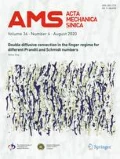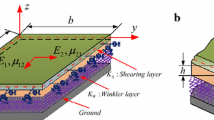Abstract
This article presents closed-form solutions for the frequency analysis of rectangular functionally graded material (FGM) thin plates subjected to initially in-plane loads and with an elastic foundation. Based on classical thin plate theory, the governing differential equations are derived using Hamilton’s principle. A neutral surface is used to eliminate stretching–bending coupling in FGM plates on the basis of the assumption of constant Poisson’s ratio. The resulting governing equation of FGM thin plates has the same form as homogeneous thin plates. The separation-of-variables method is adopted to obtain solutions for the free vibration problems of rectangular FGM thin plates with separable boundary conditions, including, for example, clamped plates. The obtained normal modes and frequencies are in elegant closed forms, and present formulations and solutions are validated by comparing present results with those in the literature and finite element method results obtained by the authors. A parameter study reveals the effects of the power law index n and aspect ratio a/b on frequencies.


Similar content being viewed by others
References
Koizumi, M.: The concept of FGM. Ceram. Trans. Func. Grad. Mater. 34, 3–10 (1993)
Koizumi, M.: FGM activities in Japan. Compos. Pt B. Eng. 28, 1–4 (1997)
Xing, Y.F., Liu, B.: New exact solutions for free vibrations of rectangular thin plates by symplectic dual method. Acta. Mech. Sin. 25, 265–270 (2009)
Xing, Y.F., Liu, B.: New exact solutions for free vibrations of thin orthotropic rectangular plates. Compos. Struct. 89, 567–574 (2009)
Xing, Y.F., Xu, T.F.: Solution methods of exact solutions for free vibration of rectangular orthotropic thin plates with classical boundary conditions. Compos. Struct. 104, 187–195 (2013)
Yang, J., Shen, H.S.: Dynamic response of initially stressed functionally graded rectangular thin plates. Compos. Struct. 54, 497–508 (2001)
Abrate, S.: Free vibration, buckling, and static deflections of functionally graded plates. Compos. Sci. Technol. 66, 2383–2394 (2006)
Abrate, S.: Functionally graded plates behave like homogeneous plates. Compos. Pt B. Eng. 39, 151–158 (2008)
Zhang, D.G., Zhou, Y.H.: A theoretical analysis of FGM thin plates based on physical neutral surface. Comput. Mat. Sci. 44, 716–720 (2008)
Yin, S., Yu, T., Liu, P.: Free vibration analyses of FGM thin plates by isogeometric analysis based on classical plate theory and physical neutral surface. Adv. Mech. Eng. 5, 634584 (2013)
Li, S.R., Wang, X., Batra, R.C.: Correspondence relations between deflection, buckling load, and frequencies of thin functionally graded material plates and those of corresponding homogeneous plates. J. Appl. Mech. 82, 111006 (2015)
Thai, H.T., Uy, B.: Levy solution for buckling analysis of functionally graded plates based on a refined plate theory. J. Mech. E. Pt C. 227, 2649–2664 (2013)
Reddy, J.N., Wang, C., Kitipornchai, S.: Axisymmetric bending of functionally graded circular and annular plates. Eur. J. Mech. 18, 185–199 (1999)
Hosseini-Hashemi, S., Fadaee, M., Atashipour, S.R.: A new exact analytical approach for free vibration of Reissner–Mindlin functionally graded rectangular plates. Int. J. Mech. Sci. 53, 11–22 (2011)
Reddy, J.N.: Analysis of functionally graded plates. Int. J. Numer. Meth. Eng. 684, 663–684 (2000)
Yang, J., Shen, H.S.: Vibration characteristics and transient response of shear deformable functionally graded plates in thermal environments. J. Sound. Vib. 255, 579–602 (2002)
Kim, Y.W.: Temperature dependent vibration analysis of functionally graded rectangular plates. J. Sound. Vib. 284, 531–549 (2005)
Swaminathan, K., Naveenkumar, D.T., Zenkour, A.M., et al.: Stress, vibration and buckling analyses of FGM plates–a state-of-the art review. Compos. Struct. 120, 10–31 (2015)
Thai, H.T., Kim, S.E.: A review of theories for the modeling and analysis of functionally graded plates and shells. Compos. Struct. 128, 70–86 (2015)
Sayyad, A.S., Ghugal, Y.M.: On the free vibration analysis of laminated composite and sandwich plates: a review of recent literature with some numerical results. Compos. Struct. 129, 177–201 (2015)
Reddy, J.N., Chin, C.D.: Thermomechanical analysis of functionally graded cylinders and plates. J. Therm. Stresses. 21, 593–626 (1998)
Acknowledgments
The project was supported by the National Natural Science Foundation of China (Grants 11172028, 1372021), Research Fund for the Doctoral Program of Higher Education of China (Grant 20131102110039), and the Innovation Foundation of Beihang University for PhD graduates.
Author information
Authors and Affiliations
Corresponding author
Appendices
Appendix 1
Here the elastic foundation and in-plane loads are not involved. The dimensionless natural frequency parameter is \(\omega ^{{*}}=\omega a^{2}\sqrt{\rho h/D}\). As for the SUS304 and \(\hbox {Si}_{3}\hbox {N}_{4}\) plates, we have
From Eq. (24) one finds that the frequency parameter \(\omega ^{{*}}\) is the same for thin plates with different materials since the elastic foundation and in-plane loads are not taken into account here, that is
Substitution of Eq. (A1) into Eq. (A2) yields
Yang and Shen [6] used the dimensionless natural frequency parameter \(\omega ^{*}=\omega a^{2}\sqrt{\rho _{\mathrm{SUS304}} h/D_{\mathrm{SUS304}} }\) for plates with different materials, then
from which we have
To substitute the material properties of SUS304 and \(\hbox {Si}_{3}\hbox {N}_{4}\) as given in Table 3 into Eq. (A3), and to substitute the ensuing results into Eq. (A5), one can obtain that the ratio of the frequency parameter \(\omega ^{*}\) between \(\hbox {Si}_{3}\hbox {N}_{4 }\) and SUS304 is 2.2579 (Table 13). In Sect. 4.1, we use the same dimensionless natural frequency parameter as Yang and Shen [6] in numerical comparisons, \(\omega _{\mathrm{Si}_3 \mathrm{N}_4 }^{*} / \omega _{\mathrm{SUS304}}^{*} \), which is also 2.2579 (Table 13); therefore, it can be concluded that the present results are correct. But using the numerical results of Yang and Shen [6], \(\omega _{\mathrm{Si}_3 \mathrm{N}_4 }^{*} /\omega _{\mathrm{SUS304}}^{*} \) is 1.2164, and this shows that some numerical results of Yang and Shen [6] may not be correct.
Appendix 2
The differential operators in Eq. (18) are as follows
And the boundary conditions derived using Hamilton’s principle have the following forms:
The shear forces are given by following relations:
Rights and permissions
About this article
Cite this article
Xu, T.F., Xing, Y.F. Closed-form solutions for free vibration of rectangular FGM thin plates resting on elastic foundation. Acta Mech. Sin. 32, 1088–1103 (2016). https://doi.org/10.1007/s10409-016-0600-4
Received:
Revised:
Accepted:
Published:
Issue Date:
DOI: https://doi.org/10.1007/s10409-016-0600-4




